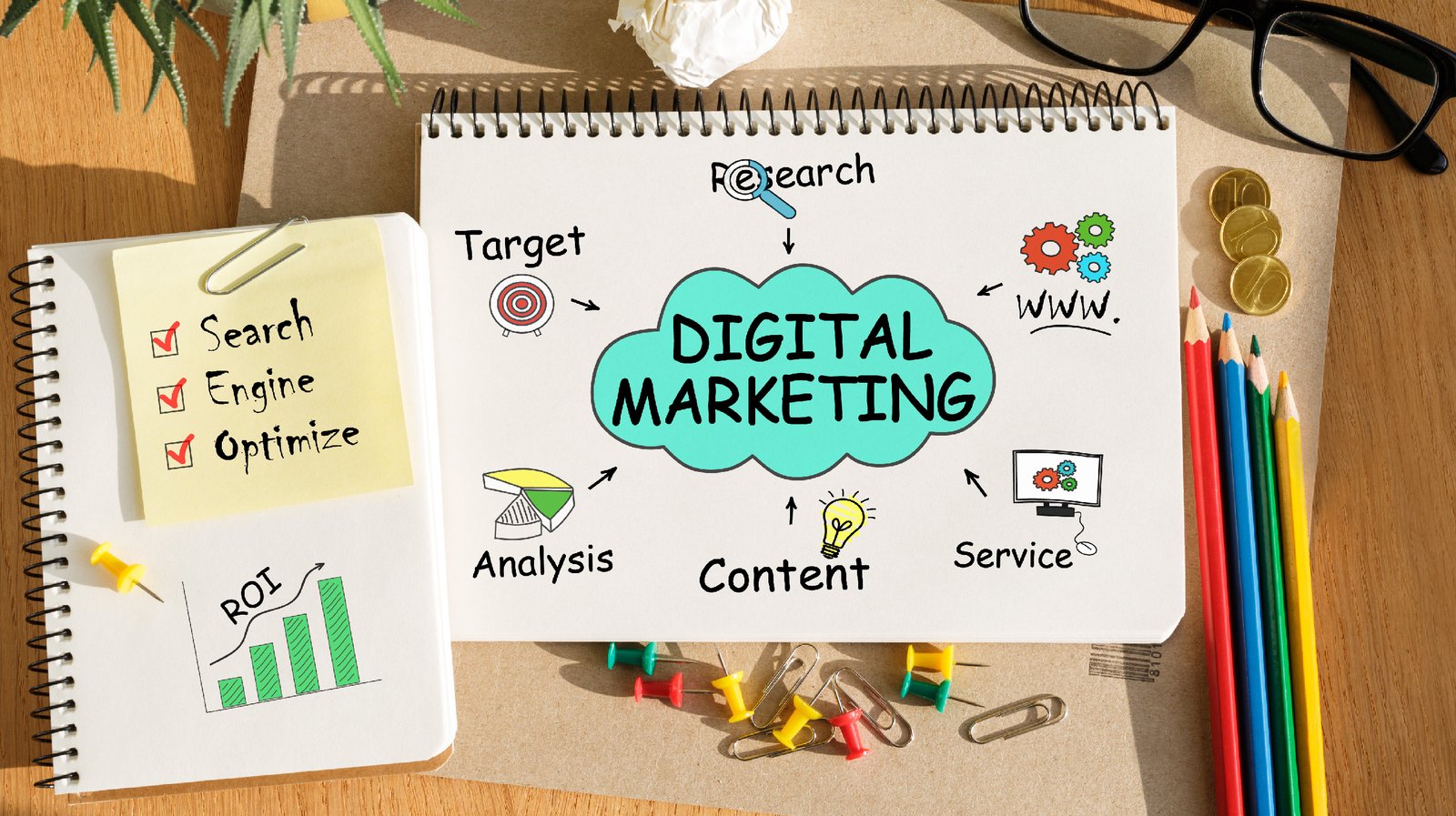Maximizing ROI with Effective Digital Marketing Strategies
In today’s fast-paced, digital-first world, businesses of all sizes are realizing the importance of investing in digital marketing strategies. However, simply implementing digital marketing tactics isn’t enough. To achieve sustainable growth and success, businesses must focus on maximizing their return on investment (ROI) through carefully planned and executed strategies. But how can companies ensure that their marketing efforts are not only reaching the right audience but also driving measurable results? Let’s explore the best practices and strategies for maximizing ROI with effective digital marketing.
Understanding ROI in Digital Marketing
ROI (Return on Investment) in digital marketing refers to the measurement of the profitability of the marketing efforts. It’s a key metric used by businesses to determine how effectively their marketing dollars are being spent. The formula for calculating ROI is:

In simple terms, ROI shows how much revenue you earn for every dollar you invest in marketing. Maximizing ROI means optimizing your digital marketing efforts so that you achieve the highest possible returns, while minimizing waste and inefficiencies.
- Set Clear, Measurable Goals
One of the first steps in maximizing ROI is setting clear, measurable goals. Digital marketing can involve many channels and tactics, from SEO to social media to paid advertising. However, without clear objectives, it’s difficult to determine whether those efforts are generating a positive return.
For example, instead of vague goals like “increase website traffic,” aim for more specific, measurable goals such as “increase organic website traffic by 30% in six months” or “generate 500 leads via Facebook Ads in one month.” These specific objectives allow you to track your performance over time and make data-driven decisions to improve your strategy.
Setting measurable goals ensures you know exactly what success looks like, and it gives you a benchmark to assess your digital marketing efforts. Regularly track your progress to ensure you’re staying on track to achieve these goals.
- Focus on Targeted Audience Segmentation
The key to maximizing ROI lies in ensuring that your marketing efforts reach the right people. Broad, unfocused campaigns often result in wasted ad spend and limited conversions. By segmenting your audience based on demographics, behavior, preferences, and pain points, you can deliver personalized and targeted messaging that resonates with potential customers.
For example, rather than running a generic Facebook Ads campaign, you can create different ad sets targeting specific segments—such as location-based groups, age groups, or individuals who have previously interacted with your business. Personalized ads speak directly to the needs and desires of the audience, leading to higher engagement rates and better conversion potential.
Using tools like Google Analytics, Facebook Audience Insights, and CRM systems can help you gather valuable data to define audience segments more accurately. By targeting the right audience with the right message, you significantly increase the likelihood of conversions, driving higher ROI.
- Optimize Your Website for Conversions
Your website is the foundation of your digital marketing efforts, and if it’s not optimized for conversions, you’re leaving money on the table. A website that is poorly designed, difficult to navigate, or lacks clear calls to action (CTAs) can lead to a high bounce rate and lost opportunities.
To maximize ROI, ensure your website is optimized to convert visitors into leads or sales. This includes:
- Optimizing page load speed: A slow-loading website can frustrate users and result in higher bounce rates.
- Clear and compelling CTAs: Each page on your site should have a clear CTA guiding users on what to do next (e.g., “Buy Now,” “Request a Demo,” or “Get Started”).
- Responsive design: Ensure your website is mobile-friendly, as more and more users browse and shop on their mobile devices.
- Landing pages: Dedicated landing pages for specific campaigns can increase conversion rates by focusing on a single offer and removing distractions.
- User experience (UX): The website design should be intuitive, easy to navigate, and align with the user’s journey.
A well-designed, high-converting website enhances the impact of all your digital marketing efforts, ensuring that you get the maximum return for your investments.
- Leverage SEO for Long-Term Success
Search Engine Optimization (SEO) is one of the most effective ways to achieve a high ROI in digital marketing. Unlike paid ads that stop generating traffic once the budget runs out, SEO offers long-term benefits by driving organic traffic to your website consistently.
Optimizing your website and content for search engines can bring in high-quality leads without ongoing advertising costs. Focus on the following SEO tactics:
- Keyword research: Identify relevant keywords that your target audience is searching for. Focus on a mix of short-tail and long-tail keywords to attract both high-volume and niche traffic.
- On-page optimization: Optimize titles, meta descriptions, header tags, and URL structures to align with target keywords.
- Content marketing: Regularly produce high-quality, valuable content that answers your audience’s questions, solves their problems, and addresses their needs.
- Technical SEO: Ensure your website is technically optimized for search engines by improving page speed, fixing broken links, and creating an XML sitemap.
Investing in SEO not only boosts your visibility but also helps you connect with users who are actively looking for your products or services, increasing the likelihood of conversion and delivering high ROI over time.
- Utilize Paid Advertising Wisely
While organic tactics like SEO can yield long-term results, paid advertising can help drive immediate results and accelerate growth. However, to maximize ROI with paid campaigns, you need to make smart, strategic decisions.
Whether you’re using Google Ads, Facebook Ads, or other platforms, here are some strategies for improving the ROI of your paid campaigns:
- Retargeting: Retarget users who have visited your website but didn’t convert. Retargeting ads tend to be highly cost-effective since they target warm leads who are already familiar with your brand.
- A/B Testing: Constantly test different ad creatives, headlines, and targeting options to see which combinations deliver the best results.
- Focus on high-converting keywords and audiences: Allocate more of your budget to the most profitable keywords and target audiences that have shown a higher conversion rate.
- Optimize your bidding strategy: Use smart bidding techniques, such as cost-per-click (CPC) or cost-per-acquisition (CPA) to ensure you’re maximizing the effectiveness of your ad spend.
Paid ads can offer a fast way to increase traffic and conversions, but ensuring your campaigns are optimized will help you maximize ROI while minimizing waste.
- Measure, Analyze, and Adapt
One of the most critical components of maximizing ROI is data analysis. Without tracking your campaigns’ performance, you won’t know where to allocate your resources for the best returns. Use analytics tools like Google Analytics, Facebook Insights, and email marketing dashboards to measure key performance indicators (KPIs) such as traffic, conversions, bounce rate, and customer acquisition costs.
Regularly assess your campaigns and make data-driven decisions to optimize your strategy. If a particular channel or tactic is underperforming, pivot and adjust. Digital marketing is not static; it’s an ongoing process of testing, learning, and adapting.
- Invest in Email Marketing for High ROI
Email marketing is one of the most cost-effective digital marketing strategies with one of the highest ROI rates. With an average ROI of 4200%, email marketing can drive significant revenue for your business if executed correctly.
To maximize the ROI from email marketing, focus on:
- Segmentation: Group your email list based on customer behavior, demographics, or interests to send more personalized and relevant emails.
- Automation: Set up automated email campaigns to nurture leads, welcome new subscribers, and re-engage inactive customers.
- Clear and compelling CTAs: Every email should have a strong, action-oriented CTA that encourages recipients to take the next step, whether it’s making a purchase, signing up for a webinar, or downloading a resource.
Email marketing, when done well, can lead to better customer retention, higher engagement, and a more consistent stream of revenue, making it one of the best digital marketing tactics for ROI.
Conclusion: Maximizing ROI Requires Strategy, Testing, and Adaptation
Maximizing ROI in digital marketing is not about throwing money at various tactics and hoping for the best. It’s about making smart, data-driven decisions and continuously refining your strategies for the best possible outcomes. By setting clear goals, targeting the right audience, optimizing your website, leveraging SEO, using paid ads wisely, and measuring performance, you can maximize your digital marketing ROI and ensure your business continues to thrive in an ever-competitive online landscape.
Remember, digital marketing is an evolving field, and to truly maximize ROI, businesses must commit to constant optimization and stay agile in adapting to new trends, technologies, and customer behaviors.


